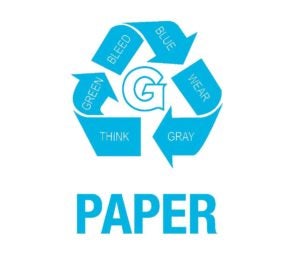Paper Recycling

Worldwide, the pulp and paper industry is the fifth largest consumer of energy, accounting for four percent of all the world’s energy use. Pulp and paper mills contribute to air, water and land pollution and discarded paper and paperboard make up roughly 26% of solid municipal solid waste in landfill sites.
Recycling one ton of paper can save 17 trees, 7,000 gallons of water, 380 gallons of oil, 3.3 cubic yards of landfill space and 4,000 kilowatts of energy — enough to power the average home for six months — and reduce greenhouse gas emissions by one metric ton of carbon equivalent (MTCE).
Recycling paper conserves natural resources, saves energy, reduces greenhouse gas emissions, and keeps landfill space free for other types of trash that can’t be recycled
How can you help GU-Q have a more environmentally sustainable culture?
Reduce
- Don’t print unnecessary emails and encourage others not to either.
- Include a message in your email signature like “Please consider the environment before printing this email.”
- Instructions for email programs: Georgetown Google Mail
- Photocopy on both sides.
- For assistance in how to copy on duplex, please ask Don in the mailroom or the office assistant in your department.
- Instructions for duplex copying
- Print on both sides of the paper.
- Instructions on how to print double-sided
Reuse
- Use your old paper for scrap.
- The office assistants will gladly cut paper that is used on one side and make it into small memo pads. Pads of one-side used paper are available in the office supply room.
- Print on the other side of used paper.
- Need to print a draft? Why not load your printer tray with paper that is already used on one side.
Recycle
- Put paper products in the recycling boxes.
- There are recycling boxes located next to all of the large printers and photocopiers. This paper is taken to Al Suwaidi Paper Factory in the Industrial Area. There, it is used to make cardboard.
Recycle paper from your home as well.
- Many of the Georgetown GU-Q staff housing compounds have paper recycling collection stations. If there is no recycling at your home, bring paper in from home to recycle at the university.
What can you put in our Paper recycling bins at GU-Q?
- Cardboard
- Boxes
- Newspapers
- Magazines
- Office Paper
What you cannot put in our Paper recycling bins at GU-Q?
- Greasy Containers
- Paper Towels
- Dirty Tissue/Napkins
- Drink Cartons
- Paper/Wax Cups
Why they cannot go in?
- Greasy Containers: When paper is recycled, it is mixed with water to form slurry. Oil and fat from food residue don’t mix with water; instead, they float on top of the slurry and mingle with the paper pulp. Oily pulp makes very poor quality paper and is, in effect, unusable. Paper products with grease or food residue, such as pizza boxes, should not be put in the recycling bin. Instead, compost it or just throw it in the trash.
- Paper/Wax Cups: Your disposable coffee cup might seem like it can be recycled, but most single-use cups are lined with a fine film of polyethylene, which makes the cups liquid-proof but also difficult and expensive to reprocess (because the materials have to be separated). Most waste management facilities will treat the cups as trash. If you’re putting these cups in with your recycling, they are likely contaminating the rest of the materials.
- Paper Towels/Dirty Tissues/Napkins: Paper towels, napkins, paper plates, and tissues are all paper products usually come in contact with food wastes, greases, and possibly bodily fluids, they are not able to be “cleaned” during the recycling process and should not be with other “clean” paper waste like magazines and copy paper. A dirty paper towel or napkin could harbor all kinds of nastiness that could ruin an entire batch of recyclables.